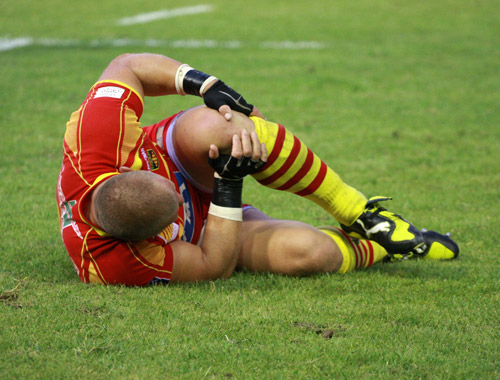The Jump Pad
The Jump Pad is a safe, flat inflatable made in a variety of sizes which can be used indoor or outdoor. From 3mx3m up to a whopping 9mx21m. Markets include Indoor and outdoor playgrounds, schools,…
read more
New research has revealed the rate of hospitalisation for sports injuries is significantly higher in regional Australia than in metropolitan areas, challenging the way in which policy makers think about health service delivery.
Professor Caroline Finch, from Federation University Australia in Ballarat, has analysed seven years of hospital admissions data from across Victoria, to identify population sub-groups which have higher rates of injury hospitalisation.
She found that 182 adults per 100,000 per year were admitted to a regional hospital with a sporting injury, compared to just 140 adults per 100,000 in metropolitan areas.
Commenting on her findings, Professor Finch explained “for every year in this study, rural and regional areas had higher rates of sports injury hospital admissions than metropolitan areas, for both children and adults.
“These findings highlight the need for pro-active guidance for regional health services to both keep pace with the healthcare demands of sports injuries and to prevent them occurring in such high numbers.”
Professor Finch, who will present her findings to next month’s RUN Regional Futures Conference in Rockhampton, said the data only covered cases where the patient was admitted to hospital over one or more nights, which were usually the more severe injuries such as fractures or concussions.
She added “as they result in hospital admission, these are the most expensive injuries to treat, and they are also the types of injuries which can have life-long implications.
“This gives policy makers extra reason to think about the way in which services are provided in regional areas, particularly given the fact that sport is such an integral part of the social fabric of these communities.”
Professor Finch said access to both basic and allied health services, injury prevention programs, and the quality of sporting facilities, were all areas requiring examination.

She continued “what we suspect is happening is more people are being admitted in hospitals in regional areas due to the lack of allied health services which are available in the city. For example, we know there are fewer GPs and fewer physiotherapists in regional areas.
“We also know that there are more injuries from contact football and wheeled motorsports in regional areas than in the city, and this may be due to the quality of the facilities where teams are playing, such as dry or bare-turfed footy fields.
“With rural and regional communities also suffering higher rates of obesity and heart diseases, it is really important that we further research this area because we want more people playing sport so that they lead healthier lifestyles, but we don’t want to see them suffering life-long injuries from participating.”
Professor Finch is one of more than 60 researchers who will be speaking at the 2016 RUN Regional Futures Conference, an initiative of the Regional Universities Network (RUN) to be held at CQUniversity Rockhampton from 21st to 24th June.
Like many of the speakers, Professor Finch is a leader in her field, heading up the Australian Collaboration for Research into Injury in Sport and its Prevention, one of only nine research centres around the world which is supported by the International Olympic Committee (IOC).
RUN is comprised of six regional universities - CQUniversity, Federation University Australia, Southern Cross University (SCU), University of New England (UNE), University of Southern Queensland (USQ), and University of the Sunshine Coast (USC).
The conference will address the challenges facing regional Australia and draw attention to the ways in which universities can work with government, community and industry, to drive innovation, engagement and research, and create vibrant, successful futures for regional economies and communities.

The program will feature presentations from research students, academics, politicians, community and industry representatives under five theme areas of Economic, Healthy, Sustainable, Digital and Creative futures and will also feature keynote talks from Dr Geoff Garrett, the Chief Scientist of Queensland; Jack Archer, Chief Executive Officer, Regional Australia Institute (RAI); and Nick Behrens, Director Advocacy & Workplace Relations, Chamber of Commerce and Industry Queensland (CCIQ).
Click here for details on the Regional Futures Conference in the Australasian Leisure Management industry Calendar.
25th April 2015 - WESTERN QUEENSLAND DROUGHT IMPACTS LOCAL SPORT
1st February 2015 - REPORT SUGGESTS ELITE AND GRASSROOTS SPORT AT RISK FROM CLIMATE CHANGE
20th January 2014 - RESEARCH REVIEW SUGGESTS BENEFITS OUTWEIGH THE RISKS OF INJURY IN JUNIOR SPORT
28th November 2013 - STUDY SHOWS THAT CHILDREN CONCUSSED WHILE PLAYING SPORT DON’T GET PROPER TREATMENT
12th July 2011 - SPORTS INJURIES KEEPING HOSPITAL BEDS WARM
Asking a small favour
We hope that you value the news that we publish so while you're here can we ask for your support?
The news we publish at www.ausleisure.com.au is independent, credible (we hope) and free for you to access, with no pay walls and no annoying pop-up ads.
However, as an independent publisher, can we ask for you to support us by subscribing to the printed Australasian Leisure Management magazine - if you don't already do so.
Published bi-monthly since 1997, the printed Australasian Leisure Management differs from this website in that it publishes longer, in-depth and analytical features covering aquatics, attractions, entertainment, events, fitness, parks, recreation, sport, tourism and venues management.
Subscriptions cost just $90 a year.
Click here to subscribe.
Support our industry news service
We hope that you value the news that we publish so while you're here can we ask for your support?
As an independent publisher, we need reader support for our industry news gathering so ask that - if you don't already do so - you back us by subscribing to the printed Australasian Leisure Management magazine and/or our online news.
The Complete Guide to Leisure Industry Products & Services.
The Jump Pad is a safe, flat inflatable made in a variety of sizes which can be used indoor or outdoor. From 3mx3m up to a whopping 9mx21m. Markets include Indoor and outdoor playgrounds, schools,…
read moreLinks Modular Solutions was a leading provider of high-quality, innovative software solutions for aquatic and recreation facilities. Links Modular Solutions is now part of Xplor Technologies.
read moreWe are the leading providers of kids fun multi-sports programs for Sport and Recreation Centres. Programs cover twelve common sports as well as Gross Motor Skill Development and suit children from as…
read moreStadiums and venues around the world recognise that success hinges on more than just what happens on the pitch. More than ever, fan engagement within each facility is a critical part of the overall…
read moreAs of February 2023, Ungerboeck Software has rebranded as Momentus Technologies.
read moreOur team believes floors should be beautiful, comfortable, and engineered for safety, even when wet. Life Floor tiles meet six unique performance based standards: slip-resistance, impact absorption,…
read moreClubware’s online gym software is not your run of the mill management system. It has been carefully designed to incorporate all the elements that a fitness club would need. How did we do that?…
read moreGeoff Ninnes Fong & Partners (GNFP) is a structural, aquatic and civil engineering consultancy with broad experience in the design of new municipal and institutional swimming pools, hydrotherapy…
read moreGet your business noticed in our targeted directory. Viewed by 10,000 industry professionals per week!